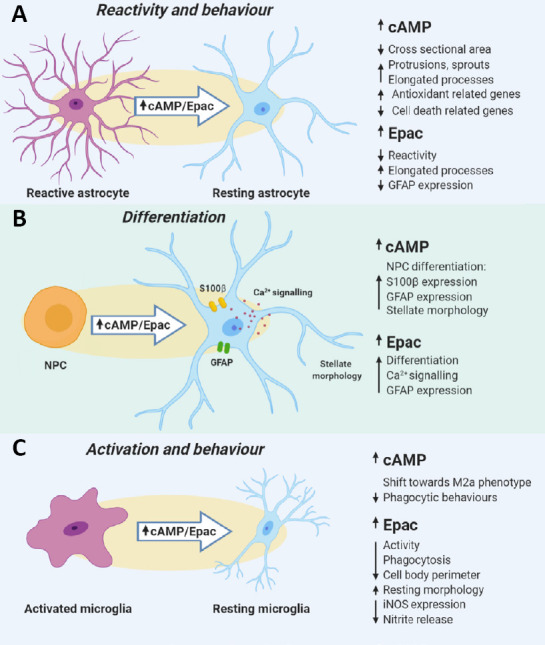Figure 6.

Effects of elevated cAMP and increased Epac activity on glial cells.
(A) In resting astrocytes, elevation of cAMP results in morphological changes such as a decrease in cross sectional area, increased elongation of processes and an increase in the number of sprouts and protrusions from the cell. What is more, cAMP elevation can shift a genetic profile of astrocytes towards a pro-survival state by inducing expression of antioxidant-related genes and downregulation of cell death-related genes. In reactive astrocytes, activation of Epac2 led to a decrease in GFAP expression as well as induced morphology that resembled resting astrocytes. (B) The elevation of cAMP or Epac was found to induce differentiation of NPCs to astrocytes. The upregulation of S100β and GFAP expression, as well as a shift to a stellate morphology, was observed in NPCs treated with a cAMP elevating agent or Epac2 agonist. (C) In microglia, an increase in cAMP levels was found to be essential to shift M1 to M2 microglia in the presence of IL-4, which suggests that cAMP is crucial to controlling microglial behaviour. What is more, either elevation of cAMP or activation of Epac decreased the phagocytic behaviours of the BV-2 cells. In the ex vivo model of SCI, treatment of the tissue with Epac2 agonist resulted in a decrease in microglial iNOS expression and nitrite release, as well as an induction of resting-like morphology, which indicates that Epac controls not only the reactivity of astrocytes, but also the activation of microglia. cAMP: Cyclic adenosine 3′,5′-monophosphate; GFAP: glial fibrillary acidic protein; iNOS: inducible nitric oxide synthase; IL: interleukin; NPCs: neural precursor cells; SCI: spinal cord injury.
